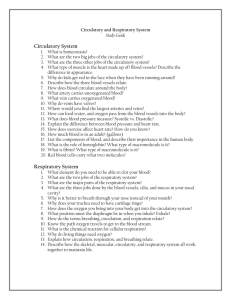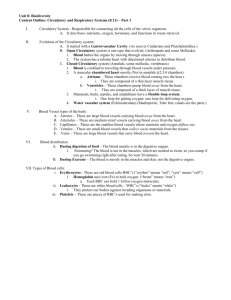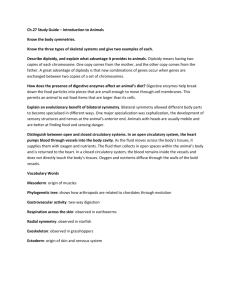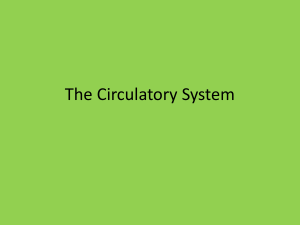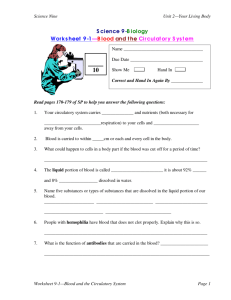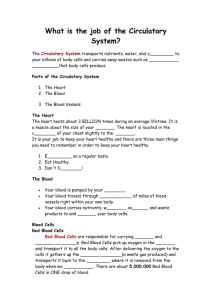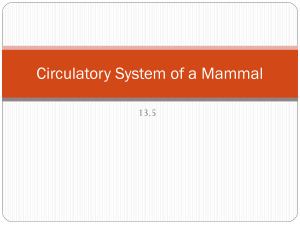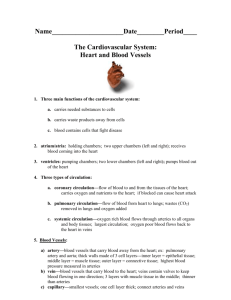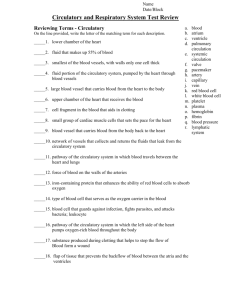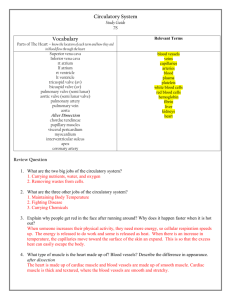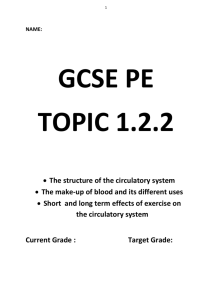File - Zena Tarabishi
advertisement
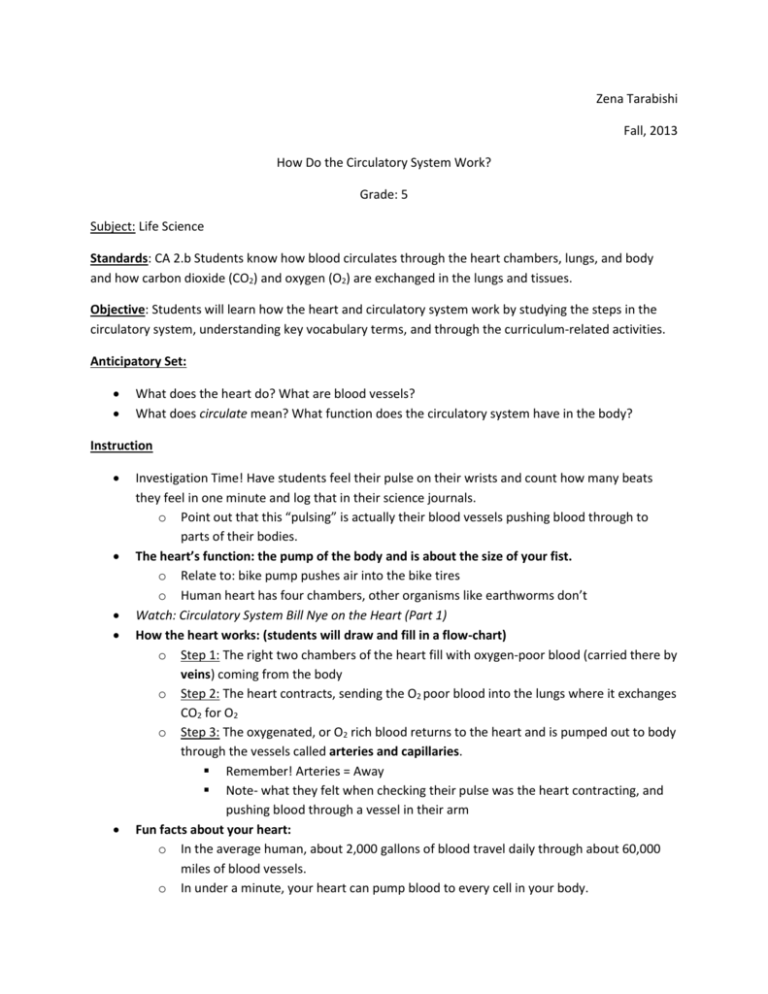
Zena Tarabishi Fall, 2013 How Do the Circulatory System Work? Grade: 5 Subject: Life Science Standards: CA 2.b Students know how blood circulates through the heart chambers, lungs, and body and how carbon dioxide (CO2) and oxygen (O2) are exchanged in the lungs and tissues. Objective: Students will learn how the heart and circulatory system work by studying the steps in the circulatory system, understanding key vocabulary terms, and through the curriculum-related activities. Anticipatory Set: What does the heart do? What are blood vessels? What does circulate mean? What function does the circulatory system have in the body? Instruction Investigation Time! Have students feel their pulse on their wrists and count how many beats they feel in one minute and log that in their science journals. o Point out that this “pulsing” is actually their blood vessels pushing blood through to parts of their bodies. The heart’s function: the pump of the body and is about the size of your fist. o Relate to: bike pump pushes air into the bike tires o Human heart has four chambers, other organisms like earthworms don’t Watch: Circulatory System Bill Nye on the Heart (Part 1) How the heart works: (students will draw and fill in a flow-chart) o Step 1: The right two chambers of the heart fill with oxygen-poor blood (carried there by veins) coming from the body o Step 2: The heart contracts, sending the O2 poor blood into the lungs where it exchanges CO2 for O2 o Step 3: The oxygenated, or O2 rich blood returns to the heart and is pumped out to body through the vessels called arteries and capillaries. Remember! Arteries = Away Note- what they felt when checking their pulse was the heart contracting, and pushing blood through a vessel in their arm Fun facts about your heart: o In the average human, about 2,000 gallons of blood travel daily through about 60,000 miles of blood vessels. o In under a minute, your heart can pump blood to every cell in your body. o Beats 2.5 billion times approx. in a lifetime o Heart is about the size of your fist The Circulatory System: carries blood loaded with oxygen and nutrients to every cell of the body o made up of 3 parts: heart, blood vessels, and blood o blood cells are formed in the bone marrow, and is made up of liquid and solid parts Liquid: plasma- made up of mostly water- nutrients from food dissolve in the plasma and are carried to cells in the body, plasma also carries waste away from the cells Solids: Red/white blood cells and platelets Red blood cells- carry oxygen to all body cells white blood cells- fight infection platelets- help make clots to stop bleeding from cuts and scrapes o Remember blood flow in ABC order: Arteries, capillaries, veins Related Systems: respiratory system (breathing), skeletal (blood is made in the bone marrow), digestive (absorbing nutrients), and excretory, or urinary (filtering out wastes) Illnesses and diseases related to the Circulatory System: o Aneurysms (artery wall balloons and bursts causing dangerous bleeding), Hypertension (High Blood Pressure) when the heart works too hard, it can lead to strokes (blood flow to the brain is blocked, killing brain cells) or heart attacks; arteriosclerosis (fatty deposits in the arteries causes the walls to stiffen and thicken the walls, blocks blood) Guided Practice: Students will fill in the attached table and use it throughout the whole systems chapter to document what various systems do and how they interact. Closure: Students will share their findings from their table and (if time allows) watch a short video, “The Body Systems Rap” Independent Practice: Students will complete the attached crossword puzzle highlighting key terms and concepts related to the circulatory system. Vocabulary Circulatory system: a group of organs that transport needed materials throughout the body. Blood Vessels: Transport blood to and from the heart, o Arteries- carry oxygenated blood away from the heart to the body o Capillaries- smaller blood vessels that carry blood to cells, they exchange materials between the blood and the cells by crossing through the thin walls of the capillaries o Veins- carry blood back to the heart for oxygenation Systems of the Body Circulatory What are the parts of this system What does this system do? What other systems does it interact with? What kinds of illnesses are related to it? Fun facts! Respiratory Digestive Excretory Name: ______________________ Date: ______________________ The Super Circulatory System Crossword Puzzle Across 3. The liquid part of the blood 4. Number of chambers in the human heart 10. White blood cells are responsible for fighting off ____ (plural) 11. Help make clots to stop bleeding from injuries 12. _____ blood cells carry oxygen in the blood Down 1. Tiny blood vessels 2. A waste product that is filtered out in the lungs and exhaled 5. What the blood becomes rich in when it goes to the lungs 6. This system is responsible for the transport of needed materials throughout the body 7. Blood vessels that carry blood away from the heart 8. Where oxygen-poor blood goes after it comes back to the heart 9. Blood vessels that transports blood back to the heart Answer Key: Circulatory parts of this system Heart, blood vessels, and blood What does this system do? Circulates blood, oxygen, and nutrients throughout the body Systems it interacts with? Respiratory, digestive, excretory, skeletal Illnesses related to it? Aneurysms (artery wall balloons and bursts causing dangerous bleeding), Hypertension (HBP) heart works too hard, can lead to strokes (blood flow to the brain is blocked, killing brain cells) or heart attacks, arteriosclerosis (fatty deposits in the arteries causes the walls to stiffen and thicken the walls, blocks blood) Fun facts! In the average human, about 2,000 gallons of blood travel daily through about 60,000 miles) of blood vessels. In under a minute, your heart can pump blood to every cell in your body. Beats 2.5 billion times approx. in a lifetime Heart is about the size of your fist
